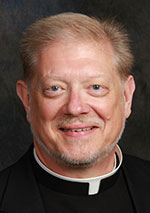That All May Be One / Fr. Rick Ginther
Connections between Passover, Easter a source of interreligious joy
 How many connections there are between Passover and Easter!
How many connections there are between Passover and Easter!
Perhaps this has slipped by us in the yearly sweep of Holy Week.
But the connections are real, so very real, not to be dismissed lightly.
Passover and Easter more often than not overlap in Jewish and Christian festal calendars. Both are determined from the lunar cycle (the first full moon after the spring equinox).
This year, Passover begins on April 15 and concludes on April 23. Easter begins on April 17 and concludes on June 5, Pentecost. (Of note, the Jewish feast of Pentecost, Shavuot, is on June 5-6 this year.)
Beyond calendric connections, there are historical ties, too.
Jesus’ meal with the disciples (the Last Supper) is a Passover meal, according to Mark, Matthew and Luke.
According to John, Jesus’ death takes place at the hour the lambs were being sacrificed for the impending Passover meal.
The resurrection of Jesus is the Sunday following Passover in all four Gospels, the day after the Jewish Sabbath.
For some early Christians, Easter was celebrated on the same day as Passover, for others at dawn on the Sunday closest (the biblical day of the resurrection).
Linguistically, there are connections.
Passover in Hebrew is “Pesach.” In various Latin-based languages, the word for Easter is related to it in French, Paques; Italian, Pasque; Spanish, Pascua.
Our English word “Easter” does not follow this pattern. Rather, it is rooted in an old German word, “eostarum,” meaning dawn or new life.
We Christians tend to connect Passover to Good Friday, the crucifixion and death of Jesus. The third-century theologian Origen noted the connection through the Greek word for suffering, “paschein.”
John’s emphasis on the blood of the lamb that saves connects to the blood of the Passover lamb.
In this case, “Passover” connotes “pass over,” the saving act by God in sparing the Hebrews through the blood sprinkled on the door frames the night of the final plague in Egypt.
The darkness of Passover night is akin to the darkness of night in which the Easter Vigil occurs. The darkness shall not triumph, proclaims the Exsultet.
Then this great song, chanted near the beginning of the Easter Vigil, recounts the leading of Israel’s children from slavery in Egypt and passing dry shod through the sea.
It continues, “this is the night when Christ broke the chains of death and rose triumphant from grave.”
For Jews of the first century, a shift in the focus of Passover occurred.
The destruction of Jerusalem and the Temple in 70 A.D. was cataclysmic. What had been a Passover emphasis on the lambs of sacrifice ended, shifting to an emphasis of shared meal, i.e., the “Seder.” That emphasis remains today.
The blood of the lamb is mentioned somewhat in passing in the Seder “ritual” meal. But the emphasis now recalls what God has done for his people: their deliverance from the “death” of slavery to new life as God’s people.
Our Easter recalls what God has done for humanity: delivered us from the “slavery to sin and death” to the new life we share now, and the eternal life to be made manifest at our resurrection.
The meal connections continue in another vein.
The festive Passover meal and Last Supper both preceded a saving event.
Both are signs of covenant promise.
Both involve death with a promise of God’s greater power of life.
Both are ritual meals.
Both have memorial words which bring forward the reality of the historical event.
Both announce the saving presence of God.
These many noted connections should raise our Judeo-Christian awareness.
May our festal celebrations, so intertwined and yet unique, be a source of interreligious joy!
(Father Rick Ginther is director of the archdiocesan Office of Ecumenism and Interreligious Affairs. He is also the pastor of Our Lady of Lourdes Parish, Indianapolis.) †
 How many connections there are between Passover and Easter!
How many connections there are between Passover and Easter!